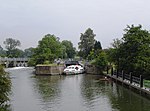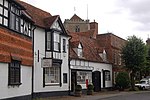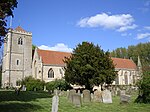Little Wittenham Bridge
Bridges in OxfordshireOxfordshire geography stubsPedestrian bridges across the River ThamesUnited Kingdom bridge (structure) stubsUse British English from February 2017

Little Wittenham Bridge is a footbridge across the River Thames in England near Dorchester-on-Thames, Oxfordshire. It is just downstream of Day's Lock on the reach above Benson Lock and connects Little Wittenham to Dorchester. The bridge spans the river in two sections with Lock House Island in between. The lock house, built in 1928 is situated on the island. The bridge is one of two used in the World Poohsticks Championships for the heats, and is used as the bridge for the final of the event.
Excerpt from the Wikipedia article Little Wittenham Bridge (License: CC BY-SA 3.0, Authors, Images).Little Wittenham Bridge
Little Wittenham Bridge, South Oxfordshire Dorchester
Geographical coordinates (GPS) Address Nearby Places Show on map
Geographical coordinates (GPS)
| Latitude | Longitude |
|---|---|
| N 51.637395 ° | E -1.179806 ° |
Address
Little Wittenham Bridge
OX14 4RB South Oxfordshire, Dorchester
England, United Kingdom
Open on Google Maps










